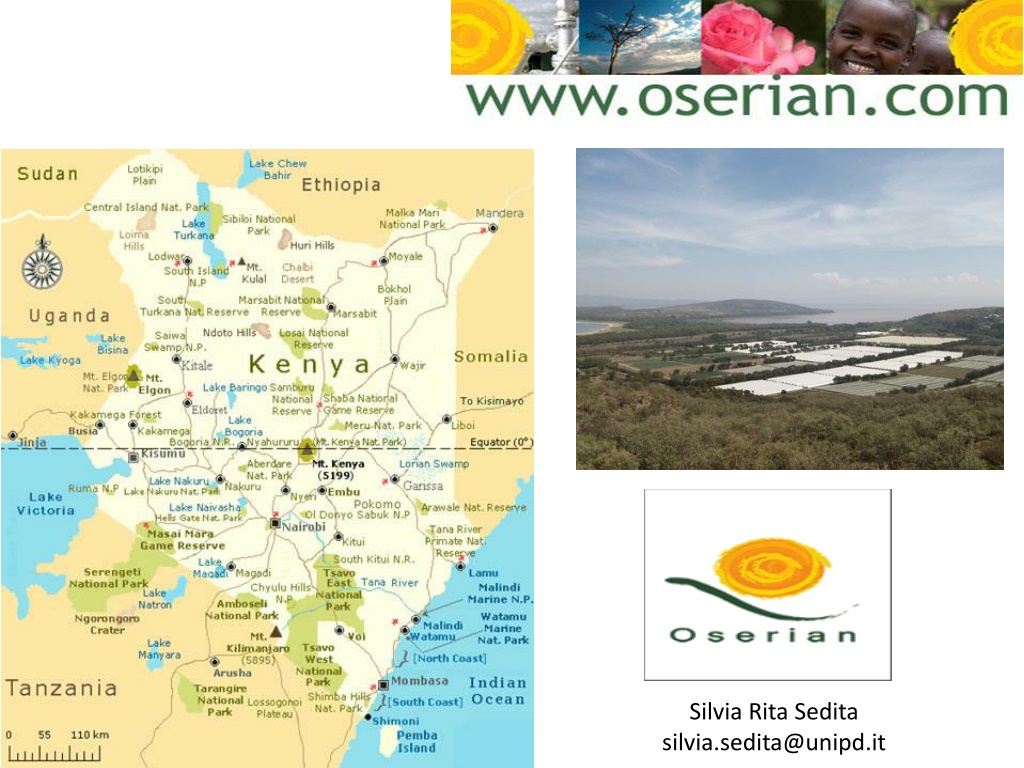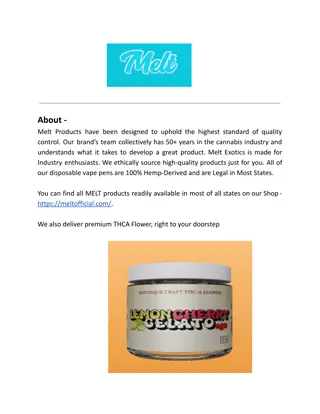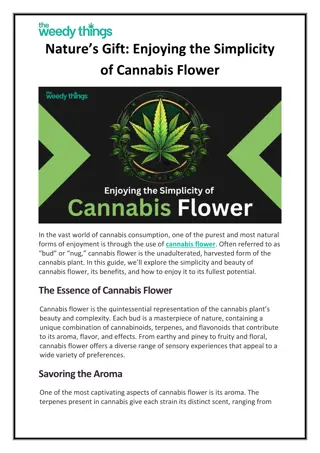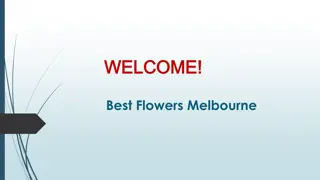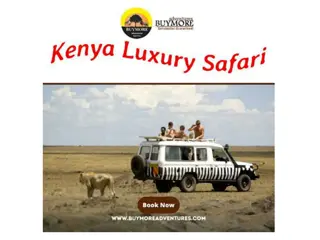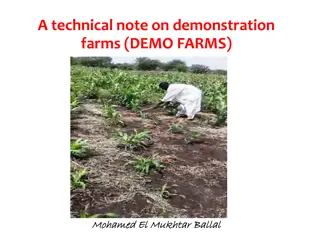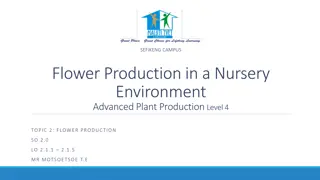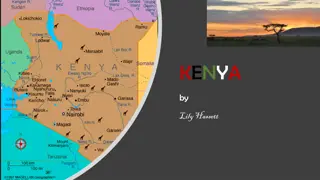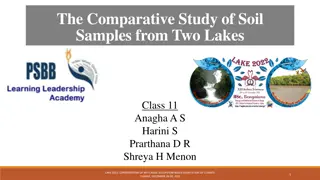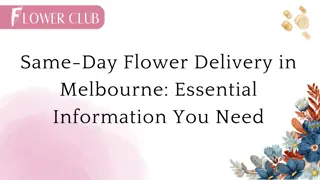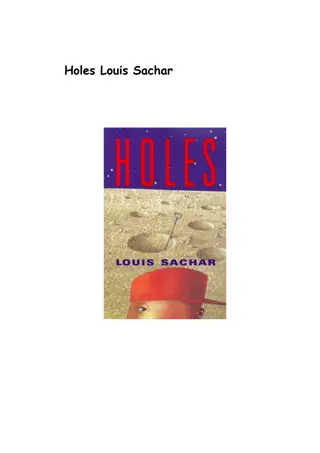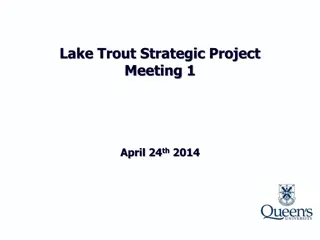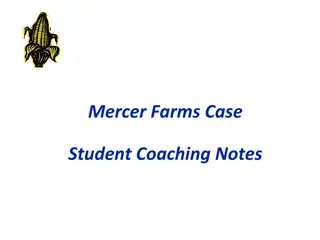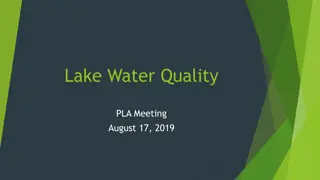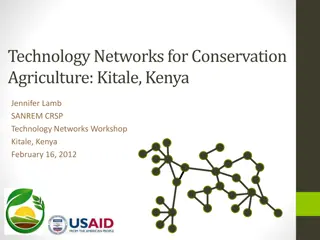Exploring the Flower Farms Around Lake Naivasha in Kenya
"Discover the rich history and thriving flower industry around Lake Naivasha, Kenya, with a focus on Oserian, a leading flower farm. Learn about the cultivation of roses, carnations, and other popular flowers in this picturesque region."
Uploaded on Nov 24, 2024 | 0 Views
Download Presentation

Please find below an Image/Link to download the presentation.
The content on the website is provided AS IS for your information and personal use only. It may not be sold, licensed, or shared on other websites without obtaining consent from the author. Download presentation by click this link. If you encounter any issues during the download, it is possible that the publisher has removed the file from their server.
E N D
Presentation Transcript
Silvia Rita Sedita silvia.sedita@unipd.it
Lake Naivasha cut-flower cluster Lake Naivasha cut-flower district is situated about 100km northwest of Nairobi, in the Great Rift Valley, at an altitude of 1800-2000m above sea level, and it comprises an area of 2000 ha including the municipalities of Naivasha, Thika, Kiambu/Limuru, Nairobi, Nakuru, Nakuru, Nanyuki/Nyahururu, Eldoret, and Mt. Kenya region. About 50%-70% of the Kenya s total cut-flower production is concentrated around Lake Naivasha, involving about 150 horticultural firms. In 1970s the principal cultivation in Kenya was fruit and vegetables for local consumption and export; the region was also specialised in the production of coffee beans, whose prices in the international markets collapsed during 1980s. In that period some local entrepreneurs decided to search for new profitable businesses and entered, first, in the cut flowers production, and, subsequently, in the cut roses (1990s). The cut-flower production started in Limuru, where local summer flowers were growing spontaneously. The oldest local farms (Oserian, Homegrown and Sulmac), were founded during the 1970s. Some years ago Flamingo Holdings (the present parent company of Homegrown) acquired Sulmac, which today operates the farm under its new name Kingfisher. Enjoy Lake Naivasha http://www.youtube.com/watch?v=oHTMOXR6XhU
Oserians History Oserian, Place of Peace in the Maasai language, is located on the Moi South Lake Road, Lake Naivasha. It is the largest flower farm of its kind in Kenya, established in 1969 as a vegetable growing farm, with a 5 hectare area of production and a workforce of six employees. Oserian started cut flower production in 1982; today, with over 20 years strong growth, is a leader in its field and the largest multi crop farm in Kenya. It employs 6,000 people and has 225 hectares of production.
Roses Oserian was one of the first farms to commercially grow and export roses to Holland from Kenya in 1984. Starting as a relatively small operation, roses are now a main crop of Oserian with 84 hectares dedicated to them. With an average of 64,000 plants per hectare, Oserian exports 3.5 million cut flower roses per week in nine different colour categories, from over twenty different varieties.
Carnation Carnations (Dianthus) are the world s third most popular cut flower. Oserian began growing carnations in the late 80 s, becoming commercially productive in the early 90 s. Now with 93 gross hectares, Oserian produces on average 3.5 million stems per week for export and is now the Largest Spray Carnation Farm in the world.
Statice & Gypsophila & Lisianthus Statice Limonium Sinutum was the first crop to be grown at Oserian. Statice s unique branches are in demand as a filler material for bouquets, corsages, baskets and other flower arrangements, the other benefit being its ever lasting nature. Gypsophila Paniculata (Baby s Breath) is used as a filler in many of Oserian s Packed At Source (PAS) bouquet product. Oserian started to grow Lisianthus in 2003. The crop is now grown in an area of 6 hectares in heated greenhouses using the Geothermal Heating capability.
The supply chain Breeding, Propagation and TC Lab The first stage of the 'seed to sale Oserian concept and process. Either through internally based TC Lab or with associations with breeders and propagators, decisions are made on crop, volume, colour mix, variety and plant behaviour. Oserian Growing and Harvesting Oserian's growing techniques,including hydroponics geothermal heating and CO2 enrichment come together with a dedicated, trained and committed workforce to ensure a top quality product. Grading Product once at the Packhouse is graded and the Cold Chain begins. Stringent measures, protocols and sophisticated systems allow for quick and accurate grading to stem length, head size, foliage removal, colour mix accuracy and other market requirements.
The supply chain Processing and Packing. Packed at Source Bouquets are Packed At Source in line with strict customer specifications. This involves value addition by adding sleeves, flower food, labels and barcoding. Dispatch to Nairobi All products are fully traceable through every process back to the field. Packed and fully labelled they are pre-chilled to specific temperatures part of the Cold Chain . After a final quality check boxes are placed on the refrigerated Oserian trucks and taken by road to Nairobi JKIA. Flight and supply of Product At Oserian Nairobi, product is prepared for air shipment and destined for supermarkets and auctions. Temperature and quality control checks ensure prime conditions so that a top quality product is received by the customer.
Mavuno Group The Mavuno Group is a conglomerate of companies incorporating services in the areas of flower breeding, propagation, production, marketing and logistics. With a company history stretching back more than 30 years in producing, sourcing, supplying and trading in the global fresh flower industry, Mavuno provides an integrated supply chain from the grower source to all market segments and customers worldwide. Mavuno Group has seven companies employing more than 6,000 staff working or trading in over 60 countries.
Technology - 1 Nature s Geothermal: Oserian s vision was to have a technological growing capability that was as advanced as the Dutch growers with full climatic control of the greenhouses, so it initiated a major investment programme to harness the geothermal energy (it is a heat and power resource that is clean and reliable) from existing geothermal wells located on the Oserian land in 2003. Oserian is unique through combining geothermal and solar energy and advanced farming techniques in its product operations. Oserian is today one of the most technologically advanced flower farms in the country: the new 50 ha Rose project employing geothermal heating and carbon dioxide makes it the largest Geothermal Greenhouse Heating Project in the world. Oserian now uses geothermal steam to produce 2 MW of electricity making the farm self sufficient in energy. Watch the video from 6 :20 to 9 :20 http://www.youtube.com/watch?v=i_PQRMe6Wpk
Technology - 2 Hydroponics: it comes from Latin and means "Working Water". With hydroponics the plants are grown in an inert growing medium (it is simply what the roots of the plants are growing in, an inert substance that doesn't supply any nutrition to the plants), the plants do not get anything from the growing medium. The plants receive only what you give them, nothing more, you have complete control over pH, nutrients (solution of water and fertilizer mixed) and the nutrient strength. Top quality production (better grade profile, larger bud size, stronger colours, larger leaves) Reduction of pesticides/fertilisers The ability to produce higher yields Water conservation and less wastage Better control and greater uniformity
Technology - 3 TISSUE CULTURE LABORATORY In 1992, as Oserian continually developed and expanded in cut flower production, the need for improved control over cultivation and the importance of having a uniform and clean starting crop were the main drivers behind the establishment of the Tissue Culture Laboratory. Oserian s Tissue Culture provides premium tissue culture plants for export and local markets.
Technology - 4 Integrated pest management The four biggest problems in cut-flower growing operations are pests: thrips, red spider mites, root knot nematodes and leaf miners. Oserian collaborates with Real IPM in order to apply IPM in a couple of greenhouses. To date, red spider mite reduction is a major success; this pest was previously controlled with toxic acaracides.
Environment Oserian is a leader in wildlife and environmental conservation and the sustainability of Lake Naivasha and its environs Water and Waste Management: Oserian s Wetland: modernised wetland to purify the Packhouse run off water as well as collection of natural rainfall. The wetland comprises of a gravel bed and three ponds designed to process this water by filtering naturally in order to make it suitable for return to the Lake; Forestry: planting of trees, general landscaping and gardening are important aspects of Oserian, that has a 1 hectare nursery which supports the indigenous species program, an exotic species program, a threatened species program and Oserian donations of seedlings to the community. Oserian Wildlife Sanctuary (Ows) & game coridors: all profits generated by tourism to the Sanctuary are dedicated to the conservation of this area and the wildlife it supports. The Sanctuary has, for example, utilised these profits to both reintroduce several endangered species such as White Rhino and Grevy Zebra as well as introduce non-indigenous species including Beisa Oryx, Greater Kudu (all trans-located from Northern Kenya), Wildebeest and Topi (from the Mara region). Oserian Wildlife Sanctuary s resident Cheetah population continues to thrive. Naivasha & Environs: any project undertaken by Oserian is first assessed through an EIA (Environmental Impact Assessment) that means a systematic examination to determine what adverse impacts on the environment a programme, activity or project may have. It is a tool for protecting the environment and ensures that environmental impacts are considered during the conception and design of any development activities, alongside economic, technical, institutional and social impacts of the up-coming project. Adverse impacts are mitigated. It is also a mechanism to ensure that a development project is designed to comply with existing environmental laws and standards.
Society Provision of human resources accomodation, healthcare and education services Education sponsorship For employees For children
Oserian Corporate Social Responsibility It provides the complete welfare of nearly 4,600 employees in health, housing, education and entertainment It has implemented a participative management culture and an open door policy in operation Operating a 48 hour working week, Oserian pays the highest floricultural wages in Kenya Oserian initiated a major investment programme to harness the geothermal energy from existing geothermal wells located on the Oserian land. Forest management Water management - hydroponics Recycling plant Integrated Pest Management 11/24/2024 16
Il caso Oserian Mind Heart Spirit Mission Champions by nature High quality products Oserian dream Oserian means place of Peace in the Masai language Vision High quality floral products and compliance with international social, ethical and environmental standards. Profit growth Stock performance (Mavuno Group) Fairtrade certification We employ highly skilled staff and adopt state of the art technology. We use top ranking local and international suppliers producing and delivering a quality products Awarded Superbrand East Africa 2012/2014 Promotion and sponsorship of various community projects and wildlife conservation projects Values Innovation Nature Childcare Sustainability 11/24/2024 Footer Text 17
